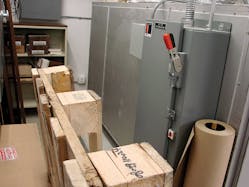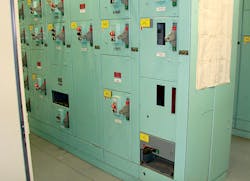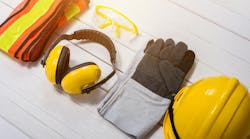Based on the ongoing evaluation of work sites in its Enforcement Programs, State-Operated Consultation Programs, and Voluntary Protection Programs (VPPs), OSHA has established a direct correlation between effective management of worker safety and health protection and the incidence and severity of employee injuries. This relates to potential hazards that could result from a change in work-site conditions or practices. In addition to reducing work-related injuries and illnesses, OSHA maintains that effective management helps eliminate or control employee exposure to toxic substances and other unhealthful conditions. It also improves employee morale and productivity as well as significantly reduces workers’ compensation costs and other less obvious costs of work-related injuries and illnesses.
Electrical inspection program
A proper inspection program is a key tool management can use in its efforts to establish and maintain an electrical safety program. The OSH Act of 1970 requires the employer to provide a safe and healthful workplace for every working man and woman. Section 5(a)(1) of the OSH Act, referred to as the “General Duty Clause,” requires each employer to furnish to each of its employees a place of employment free from recognized hazards that cause — or are likely to cause — death or serious physical harm to his employees. It also requires the employer to comply with occupational safety and health standards promulgated under the OSH Act. To assist in accomplishing this, the employer can implement a self-assessment or inspection program (see Inspection Guidelines) to ensure electrical systems and equipment are properly designed, installed, operated, and maintained in a safe and reliable condition.
To be effective, electrical safety inspections should be conducted to verify full compliance with OSHA 29 CFR 1910 electrical-related regulations, which include:
• 29 CFR 1910, Subpart I, Personal Protective Equipment
- 1910.132, General Requirements
- 1910.137, Electrical Protective Equipment
• 29 CFR 1910, Subpart J, General Environmental Controls
- 1910.146, Permit-Required Confined Spaces (as applicable)
- 1910.147, The Control of Hazardous Energy (lockout/tagout)
• 29 CFR 1910, Subpart R, Special Industries (as applicable)
- 1910.269, Electric Power Generation, Transmission, and Distribution
• 29 CFR 1910, Subpart S, Electrical Standards:
- 1910.302-.308, Design Safety Standards for Electrical Systems
- 1910.331-.335, Electrical Safety-Related Work Practices
- 1910.399, Definitions
There are also several industry consensus standards that should be considered as well, such as:
• NFPA 70, National Electrical Code
• NFPA 70E, Standard for Electrical Safety in the Workplace
• NFPA 70B, Recommended Practice for Electrical Equipment Maintenance
• ANSI/IEEE C2, National Electrical Safety Code (NESC) (as applicable)
Compliance with these regulations and standards will help to ensure employers are installing and maintaining electrical systems and equipment in proper and safe working condition as well as verifying each employee’s use of safe work practices and appropriate personal protective equipment (PPE) for shock and arc flash. Inspections also assist supervisors and managers in meeting electrical safety goals set forth by the company for regulatory compliance.
NFPA 70E-2015, Sec. 110.1(I) Electrical Safety Auditing, provides additional direction on auditing the electrical safety program on a frequency not to exceed three years and field work on a frequency not to exceed one year. This audit, which must be documented, is required to contain at least the following four components:
1. Employee implementation of the electrical safety program, which includes:
• Understanding the program.
• Identify how much supervision emphasizes the program.
• Describe the condition of the program.
2. Does the electrical safety program address all hazards (e.g., determines if employees are exposed to other risks not addressed in the program)?
3. The audit must address the process for revising procedures as needed, including:
• Where incidents or injuries occur, a review of procedures must take place.
• Procedure revisions or a new procedure may be needed.
4. Define how procedure revisions are communicated to employees.
The inspection and audit programs should be carried out by an electrically knowledgeable, qualified person in order to identify deficiencies in electrical equipment or systems — and to correct or properly document any deficiencies found.
One way to ensure the inspection program is on target is to have electrically qualified company safety personnel conduct the inspections. Another option is to contract a third-party electrical safety inspector. Using a person from outside the company or facility will often lead to discovery of issues and deficiencies that may be overlooked by self-inspecting.
The written electrical safety inspection program should be reviewed on a periodic basis by electrically qualified persons to ensure that checklists are current and being used. Inspections should include a review of the entire electrical safe work program for energized and de-energized work, which includes the energy control or lockout/tagout program. Written work practices (programs and procedures), PPE, and the condition/maintenance of installed electrical equipment and systems should be inspected for compliance with regulations and industry consensus standards.
Inspections should also include “work in progress” to ensure each worker understands and is implementing electrical safe work practices and procedures and using the proper PPE and insulated tools. This reflects directly on the qualified person training programs.
A root cause analysis of the deficiencies identified should be part of the inspection program. Changes or corrections in processes, practices, and procedures should be analyzed to help prevent a reoccurrence. Any items identified in the inspection or lessons learned should be communicated to others in the organization who might benefit from the information.
Management’s role
Management ultimately bears the burden of effectively administering the electrical safety inspection programs. Their involvement in the development and implementation of these programs is vital to success. Several areas must be considered when developing the inspection program. These include, but are not limited to, hazard assessments, inspections and audits, electrical safety training for all personnel (qualified and unqualified or electrical and non-electrical personnel), and evaluation of the existing safety management system.
To assist employers and employees in developing effective safety and health management systems, OSHA published recommended Safety and Health Program Management Guidelines (Federal Register 54(16): 3904-3916, Jan. 26, 1989). These voluntary guidelines can be applied to all places of employment covered by OSHA. The guidelines identify four general elements that are critical to the development of a successful safety and health management system.
• Management leadership and employee involvement
• Work site analysis
• Hazard prevention and control
• Safety training
In summary
Compliance with OSHA regulations and NFPA standards, along with other industry consensus standards and electrical equipment manufacturer’s instructions, provide a means to reduce accidents, injuries, and fatalities in all segments of industry.
It’s extremely important to ensure employees are always properly trained and qualified for a job. Not understanding the circumstances about the job or task can lead to accidents and injuries (see Keeping Safety Tips Top of Mind).
Even properly qualified electrical workers are susceptible to accidents. This is why it’s so important to make safety an integral part of the planning process for every single job.
Neitzel is a certified plant engineer, certified electrical safety compliance professional, and director emeritus of AVO Training Institute, Inc., Dallas. He can be reached by e-mail at [email protected].
SIDEBAR 1: Inspection Guidelines
Employers should perform a self-assessment or inspection to determine the adequacy of their written electrical safety program and procedures — and to ensure that they are being implemented. The inspection should also include an inspection of the facility’s electrical systems and equipment to ensure compliance with the installation and maintenance regulations and standards. The following questions were obtained from the OSHA Electrical Self-Inspection Checklist, which provides guidelines on what OSHA will likely look for when conducting an electrical safety inspection.
1. Do you specify compliance with OSHA for all contract electrical work?
2. Are all employees required to report as soon as practicable any obvious hazard to life or property observed in connection with electrical equipment or lines?
3. Are employees instructed to make preliminary inspections and/or appropriate tests to determine what conditions exist before starting work on electrical equipment or lines?
4. When electrical equipment or lines are to be serviced, maintained, or adjusted, are necessary switches opened, locked-out, and tagged whenever possible?
5. Are portable electrical tools and equipment grounded or of the double insulated type?
6. Are electrical appliances, such as vacuum cleaners, polishers, and vending machines, grounded?
7. Do extension cords being used have a grounding conductor?
8. Are multiple plug adapters prohibited?
9. Are ground fault circuit interrupters (GFCI) installed on each temporary 15A, 20A, and 30A – 120VAC circuit at locations where construction, demolition, modifications, alterations, or excavations are being performed?
10. Are all temporary circuits protected by suitable disconnecting switches or plug connectors at the junction with permanent wiring?
11. Do you have electrical installations in hazardous dust or vapor areas? If so, do they meet the NEC requirements for hazardous locations?
12. Is exposed wiring and cords with frayed or deteriorated insulation repaired or replaced promptly?
13. Are flexible cords and cables free of splices or taps?
14. Are clamps or other securing means provided on flexible cords or cables at plugs, receptacles, tools, equipment, etc., and is the cord jacket securely held in place? Are all cord, cable, and raceway connections intact and secure?
15. In wet or damp locations, are electrical tools and equipment appropriate for the use or location or otherwise protected?
16. Is the location of electrical power lines and cables (overhead, underground, under floor, other side of walls) determined before digging, drilling, or similar work is begun?
17. Are metal measuring tapes, ropes, handlines, or similar devices with metallic thread woven into the fabric prohibited where they could come in contact with energized parts of equipment or circuit conductors?
18. Is the use of metal ladders prohibited in areas where the ladder — or the person using the ladder — could come in contact with energized parts of equipment, fixtures, or circuit conductors?
19. Are all disconnecting switches and circuit breakers labeled to indicate their use or equipment served?
20. Are disconnecting means always opened before fuses are replaced?
21. Do all interior wiring systems include provisions for grounding metal parts of electrical raceways, equipment, and enclosures?
22. Are all electrical raceways and enclosures securely fastened in place?
23. Are all energized parts of electrical circuits and equipment guarded against accidental contact by approved cabinets or enclosures?
24. Is sufficient access and working space provided and maintained about all electrical equipment to permit ready and safe operations and maintenance?
25. Are all unused openings (including conduit knockouts) in electrical enclosures and fittings closed with appropriate covers, plugs, or plates?
26. Are electrical enclosures, such as switches, receptacles, and junction boxes, provided with tight fitting covers or plates?
27. Are disconnecting switches for electrical motors in excess of 2 hp capable of opening the circuit when the motor is in a stalled condition without exploding? (Switches must be horsepower rated equal to or in excess of the motor horsepower rating.) Is low-voltage protection provided in the control device of motors driving machines or equipment that could cause probable injury from inadvertent starting?
28. Is each motor disconnecting switch or circuit breaker located within sight of the motor control device?
29. Is each motor located within sight of its controller or the controller disconnecting means capable of being locked in the open position, or is a separate disconnecting means installed in the circuit within sight of the motor?
30. Is the controller for each motor in excess of 2 hp, rated in horsepower, equal to or in excess of the rating of the motor it serves?
31. Are employees who regularly work on or around energized electrical equipment or lines instructed in the cardiopulmonary resuscitation (CPR) methods?
32. Are employees prohibited from working alone on energized lines or equipment greater than 600V?
SIDEBAR 2: Keeping Safety Tips Top of Mind
Adherence to the following basic inspection and safety tips can help avoid serious — or even life-threatening — injuries while working with electrical equipment and systems. Important safety tips to help avoid injuries include, but are not limited to:
• Identify the electric shock and arc flash hazards as well as other hazards that may
be present.
• Use the right tools for the job.
• Isolate equipment from energy sources.
• Test every circuit and every conductor every time before you touch it.
• Work on electrical equipment and conductors only when de-energized.
• Turn off, try, test, lockout/tagout, and ground before working on equipment.
• Treat de-energized electrical equipment and conductors as energized until properly
lockout/tagout, tested, and ground procedures are implemented.
• Wear protective clothing and equipment, and use insulated tools for electrical hazards.






